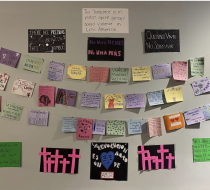Students protest gender-based violence in Latin America Favorite
For some, International Women’s Day is a day for the celebration of the social, cultural, and professional achievements of women. Many others, on the other hand, believe that we are not yet at the point of celebration, arguing that with gender inequality and gender-based violence rampant worldwide, celebrations are not what International Women’s Day should be about. In many countries, women take the holiday as an opportunity to fight for their rights and draw awareness to a variety of global issues related to women. Brandeis students from such countries drew inspiration from their communities and brought their own versions of activism to Brandeis’ campus.
Around 90,000 women gathered in the streets of Mexico City this year on International Women’s Day, according to Mexico News Daily, to march in solidarity and protest gender-based violence. The next day, they held a different kind of protest called Un Día Sin Mujeres (A Day Without Women). The aim of this protest is to simulate a world in which women do not exist. Thousands of women and girls stayed home, not just abstaining from work and school, but also refusing to leave their homes for any reason. They stayed out of stores and off the streets, away from social media, and even refrained from making online purchases. Camila Cano ’23, a Brandeis student from Mexico City, spoke to the Justice on March 13, explaining that “the idea [of the protest] is to say: If you keep on killing, if you keep making us disappear, this is what your world will look like.”
Violence against women in Mexico has been on the rise in recent years. According to a 2022 study done by Mexico’s National Institute of Statistics and Geography, 70% of all women ages 15 and older have experienced some kind of violence in their lives, with 49% of women reporting that they have experienced sexual violence. A major issue that protesters in Mexico are focusing on is the sharp increase in femicides, the murder of a woman on account of her gender, typically by a man. Femicides are a subset of homicides; all femicides are included in figures related to female homicides but not all female homicides are considered femicides. The Associated Press writes that on average, 10 women or girls are killed on a daily basis in Mexico. In 2015, 427 of the 2,161 female homicides in Mexico were considered femicides. That figure increased by 135 percent in 2021, with 1,004 of the 3,750 female homicides being classified as femicides, according to data from the Secretariado Ejecutivo del Sistema Nacional de Seguridad Pública (Executive Secretary of the National System for Public Security).
For Brandeis students from Mexico who spend International Women’s Day on campus, the lack of attention given to International Women’s Day in the United States can be jarring: “Nobody even talks about it here,” Cano said. “So we wanted to do something.” Ana Loza Pérez ’25, who also lives in Mexico City, explained in a March 16 interview with the Justice that “March 8 is a painful day to be far from home, since the narrative on that day is ‘happy’ and ‘celebrating women’ here in the U.S. Why would anyone congratulate me on being a woman when there are so many like me being raped, harassed, abused, and killed every single day around the world?”
Drawing inspiration from the protests taking place across Mexico, Cano and Pérez decided to work together and create their own form of activism on Brandeis’ campus. In the lobby of the Shapiro Campus Center, a vibrant, colorful, tendedero (clothesline) of posters hangs on the wall. Pérez explained that in Mexico, tendederos are an “important art form in the movement”: Activists often use tendederos to publicly denounce perpetrators of sexual assault and violence by writing their names and hanging them on a tendedero for all to see. Pérez and Cano were inspired by this form of activism, but instead of writing the names of perpetrators, they created a tendedero with messages and art that would raise awareness about gender violence in Latin America.







